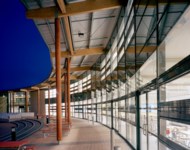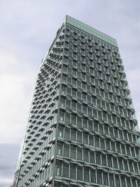Natural ventilation by design

CFD modelling techniques make it possible to design and develop natural-ventilation systems that create a comfortable internal environment.
Natural-ventilation systems that can respond fully to ever-changing outdoor conditions are much more effective than systems with limited response capability. Richard Arnott explains.Natural ventilation provides building occupiers and facilities managers with many benefits. However, designing automated systems to deliver them is a complex and detailed process to balance many internal factors and external influences to create comfortable, energy-efficient internal environments. Automated natural-ventilation systems are designed to maintain a fresh internal climate and even temperatures within buildings and rooms. They do this by sensing and monitoring various parameters within rooms and controlling the opening and closing of automated windows and other openings around the building. These systems work by utilising pressure differences created by the wind and thermal buoyancy (heat rising within the building) to drive air in and out of the building. The speed and direction of the wind are therefore critical factors that need to be taken into account within natural-ventilation systems.
 |
WindowMaster has design and installed a natural-ventilation control system for the pioneering Hadley Learning Community in Telford. |
Externally, buildings are exposed to natural elements that can change quickly, and they have a dynamic effect on its internal climate. Wind direction and strength, for example, can change in an instant, and direct sunlight can quickly turn to shade. Natural ventilation systems need to be designed to be able to compensate for these changes to ensure that rooms are maintained at a constant, even temperature. Some natural-ventilation systems are configured around ‘limited parameters’ for naturally occurring elements which are used as the basis for its operation. These are typically local seasonal average figures for hours of daylight, external temperature, wind speed, direction and pressure. The problem with this approach is that a system designed in this way will only operate effectively when external conditions are within these set parameters. They are not able dynamically to take into account and compensate for other external factors that will influence how natural elements are affecting a building. For example, a building located next to a hillside will experience different wind pressures and speeds to a similar sized building located in a built up area — despite the fact that they are in the same geographic area. Trees may have a similar effect. Wind will also have a different effect on the ground floor of a building than it will on, for example, the third floor.
 |
CFD modelling makes it possible to accurately analyse the effects of wind pressure on a building so that the benefits of natural ventilation can be fully exploited. |
The changing climate also affects systems designed in this way. Unseasonably warm periods can differ greatly from long-term average temperatures. Consequently a natural ventilation system designed around seasonal average figures will only perform effectively when external factors are within the preset limited parameters. Advanced developers of automated ventilation systems, such as WindowMaster, are however using powerful CFD (computational fluid dynamics) software to model and understand the effects of wind around individual buildings. This works with an external weather station and a detailed and flexible control strategy, which enables the company to design ventilation control systems that accurately monitor and regulate internal conditions and compensate for weather conditions outside in real time.
CFD modelling and control strategies CFD modelling makes it possible to accurately analyse the effects of wind pressure on a building. Engineering designers create 3D computer simulations of the building structure and its surrounding area, which includes objects such as trees, other buildings and hills which will affect wind flow. Once the model has been created, engineers use the software to calculate accurately the wind pressure coefficients from 16 different directions around the building. This makes it possible to predict the effect of wind on precise areas of the building to a high level of accuracy. This level of modelling enables detailed control strategies to be created. At the heart of the control strategy is the computer system that monitors and controls the airflow within a building. Information and data is fed to it from room sensors, which is analysed in conjunction with readings from an external weather station. Other important factors taken into account include the fabric of the building, its construction, size, design and how it will be used. This software also makes it possible for engineers to split buildings into different internal zones and design systems that will enable building occupiers to create different climates in separate areas.
 |
Controlled natural ventilation can also be effective in tall buildings. This is the Frauenhofer office in Munich. |
Windows are then opened or closed to millimetre accuracy to allow the precise level of airflow in to cool or ventilate rooms. During the summer, for example, the system may be optimised for night-cooling to purge a building of hot air so that it is fresh in the morning. The system will also open windows during the day to create airflow and keep rooms cool. Effective ventilation strategies and precise control can create sufficient air movement so that comfortable indoor temperatures can be achieved despite there being high outdoor temperatures. During winter months ‘pulsed ventilation’ is often used. Because the air outside is cold during winter, windows cannot be left open for a long period of time. Pulsed ventilation automatically opens windows by a variable limited distance and for a short period of time (dependent upon the external conditions) to give the required air exchange within the room. Windows are shut quickly to prevent draughts being felt by occupiers and to also prevent conflicts with the heating strategy. Other ventilation techniques, such as trickle ventilation and comfort ventilation, can also be incorporated to meet specific ventilation needs.
Conclusion Wind speed and direction are critical factors in the effective operation of natural-ventilation systems. Using limited parameters for natural elements as the basis for their control strategy will not provide sufficient depth of information to enable these systems to operate efficiently and effectively. Using powerful CFD modelling techniques makes it possible to design and develop natural ventilation systems that create a comfortable internal environment — regardless of what the weather is doing outside.
Richard Arnott is UK marketing manager with WindowMaster.
Related links:











